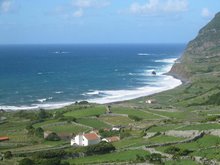 From a distance - whether floating or washed up like this one - these look like discarded bottled water bottles (it gets me every time) until you get up close and find them to be the beautiful but deadly Portuguese Man o' War jellyfish. The inflated bladder floats above the surface of the sea and they are carried along by the wind, hence the nautical name.
From a distance - whether floating or washed up like this one - these look like discarded bottled water bottles (it gets me every time) until you get up close and find them to be the beautiful but deadly Portuguese Man o' War jellyfish. The inflated bladder floats above the surface of the sea and they are carried along by the wind, hence the nautical name.OK, they're not "deadly" but I believe they're pretty blooming stingy. It's never happened to me yet but if it's anything like these big reddish-brown ones you get in Scotland which come up on anchor chains (esp nasty if a gobbet of it pings you in the face) - same with pulling up creels I expect - then I'm going to be giving POMW's a wide berth.




3 comments:
Dear Ed, It's actually considered good manners in blog-land to add links to your favourite blogs on a prominent position such as your home page, where daily visitors will see it before it slips over into blog oblivion known as "older posts". Enjoying your blog. It's making me very competitive!
I regularly look at your older posts. But I wash my hands afterwards.
Why Portuguese Man o' War? According to Wikipedia, "The common name [for Physalia physalis] comes from a Portuguese war ship type of the 15th and 16th century, the man-of-war (named caravela-portuguesa in Portuguese, caravel), which had triangular sails similar in outline to the bladder of the Portuguese Man O' War." The blurb goes on to explain that it "is not a single animal, but rather a siphonophore – a colony of four kinds of minute, highly modified individuals, which are specialized polyps and medusoids." Who'da thunk it?
http://en.wikipedia.org/wiki/Portuguese_man_o%27_war
Post a Comment